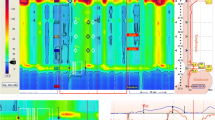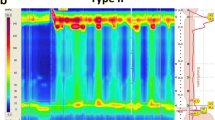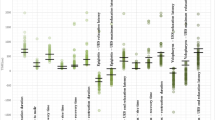Abstract
Background
Phenotypes of achalasia are based on esophageal body pressurization during swallow. The reasons that lead to pressurized waves are still unclear. This study aims to evaluate manometric parameters that may determine pressurized waves in patients with achalasia.
Methods
A total of 100 achalasia high-resolution manometry tests were reviewed. We measured before each swallow: upper esophageal sphincter (UES) basal pressure, esophageal length, lower esophageal sphincter (LES) basal pressure, LES length, gastric and thoracic pressure, transdiaphragmatic pressure gradient and the LES retention pressure (LES basal pressure-TPG); during swallow: UES pressure, UES residual pressure, UES recovery time, LES relaxation pressure, gastric and thoracic pressure, transdiaphragmatic pressure gradient and after swallow: esophageal length, LES length, wave pressure, gastric and thoracic pressure and transdiaphragmatic gradient pressure.
Results
Univariate analysis showed in pressurized waves before swallow: higher thoracic, UES and LES basal pressure, longer LES length and decrease in LES retention pressure; during swallow: higher thoracic, gastric and UES pressure, higher UES and LES relaxation pressure and after swallow: higher thoracic and gastric pressure. Multivariate analysis in pressurized waves showed as significant before swallow: thoracic and UES basal pressure; during swallow: thoracic, gastric and UES pressure, UES residual pressure and UES recovery time and after swallow: thoracic pressure.
Conclusions
Basal esophageal pressurization and the UES are independent variables that may be associated with pressurized waves.

Similar content being viewed by others
References
Kahrilas PJ, Bredenoord AJ, Fox M, Pandolfino JE et al (2015) The Chicago classification of esophageal motility disorders, v3.0. Neurogastroenterol Motil 27:160–174. https://doi.org/10.1111/nmo.12477
Pandolfino JE, Kwiatek MA, Nealis T, Bulsiewicz W, Post J, Kahrilas PJ (2008) Achalasia: a new clinically relevant classification by high-resolution manometry. Gastroenterology 135(5):1526–1533. https://doi.org/10.1053/j.gastro.2008.07.022(Epub 2008 Jul 22)
Rohof WO, Salvador R, Annese V, des Varannes SB, Chaussade S, Costantini M, Elizalde JI, Gaudric M, Smout AJ, Tack J, Busch OR, Zaninotto G, Boeckxstaens GE (2013) Outcomes of treatment for achalasia depend on manometric subtype. Gastroenterology 144(4):718–725
Andolfi C, Fisichella PM (2019) Meta-analysis of clinical outcome after treatment for achalasia based on manometric subtypes. Br J Surg 106(4):332–341. https://doi.org/10.1002/bjs.11049(Epub 2019 Jan 28)
Del Grande LM, Herbella FAM, Katayama RC, Schlottmann F, Patti MG (2018) The role of the transdiaphragmatic pressure gradient in the pathophysiology of gastroesophageal reflux. Arq Gastroenterol 55(Suppl 1):13–17. https://doi.org/10.1590/s0004-2803.201800000-39
Menezes MA, Herbella FA, Patti MG (2015) High-resolution manometry evaluation of the pharynx and upper esophageal sphincter motility in patients with achalasia. J Gastrointest Surg 19(10):1753–1757. https://doi.org/10.1007/s11605-015-2901-5
DeVault KR (1997) Incomplete upper esophageal sphincter relaxation: association with achalasia but not other esophageal motility disorders. Dysphagia 12(3):157–160
Yoneyama F, Miyachi M, Nimura Y (1998) Manometric findings of the upper esophageal sphincter in esophageal achalasia. World J Surg 22(10):1043–1046. https://doi.org/10.1007/s002689900514(discussion 1046-7)
Min M, Peng LH, Yang YS, Hou XH, Guo RB, Wang WF, Sun G, Wang XX (2012) Characteristics of achalasia subtypes in untreated Chinese patients: a high-resolution manometry study. J Dig Dis 13(10):504–509. https://doi.org/10.1111/j.1751-2980.2012.00622x
Blais P, Patel A, Sayuk GS, Gyawali CP (2017) Upper esophageal sphincter (UES) metrics on high-resolution manometry (HRM) differentiate achalasia subtypes. Neurogastroenterol Motil. https://doi.org/10.1111/nmo.13136
Triantafyllou T, Theodoropoulos C, Mantides A, Chrysikos D, Smparounis S, Filis K, Zografos G, Theodorou D (2018) Can the upper esophageal sphincter contractile integral help classify achalasia? Ann Gastroenterol 31(4):456–461. https://doi.org/10.20524/aog.2018.0270
Wauters L, Van Oudenhove L, Selleslagh M et al (2014) Balloon dilation of the esophago-gastric junction affects lower and upper esophageal sphincter function in achalasia. Neurogastroenterol Motil 26:69–76
Ren Y, Tang X, Chen F, Deng Z, Wu J, Nei S, Jiang B, Gong W (2016) Myotomy of distal esophagus influences proximal esophageal contraction and upper esophageal sphincter relaxation in patients with achalasia after peroral endoscopic myotomy. J Neurogastroenterol Motil 22(1):78–85. https://doi.org/10.5056/jnm15098
Chavez YH, Ciarleglio MM, Clarke JO, Nandwani M, Stein E, Roland BC (2015) Upper esophageal sphincter abnormalities: frequent finding on high-resolution esophageal manometry and association with poorer treatment response in achalasia. J Clin Gastroenterol 49:17–23
Mathews SC, Ciarleglio M, Chavez YH, Clarke JO, Stein E, Chander Roland B (2014) Upper esophageal sphincter abnormalities are strongly predictive of treatment response in patients with achalasia. World J Clin Cases 2(9):448–454. https://doi.org/10.12998/wjccv2.i9.448
Hong SJ, Bhargava V, Jiang Y, Denboer D, Mittal RK (2010) A unique esophageal motor pattern that involves longitudinal muscles is responsible for emptying in achalasia esophagus. Gastroenterology 139(1):102–111. https://doi.org/10.1053/j.gastro.2010.03.058
Herbella FA, Oliveira DR, Del Grande JC (2004) Are idiopathic and Chagasic achalasia two different diseases? Dig Dis Sci 49(3):353–360
Vicentine FP, Herbella FA, Allaix ME, Silva LC, Patti MG (2014) High-resolution manometry classifications for idiopathic achalasia in patients with Chagas’ disease esophagopathy. J Gastrointest Surg 18(2):221–224
Ribolsi M, Balestrieri R, Holloway H, Emerenziani S, Cicala M (2016) Intra-bolus pressure and esophagogastric gradient, assessed with high-resolution manometry, are associated with acid exposure and proximal migration of refluxate. Dis Esophagus 29:1020–1026
Pandolfino JE, El-Serag HB, Zhang Q, Shah N, Ghosh SK, Kahrilas PJ (2006) Obesity: a challenge to esophagogastric junction integrity. Gastroenterology 130:639–649
Pstras L, Thomaseth K, Waniewski J, Balzani I, Bellavere F (2016) The Valsalva manoeuvre: physiology and clinical examples. Acta Physiol (Oxf) 217(2):103–119. https://doi.org/10.1111/apha.12639(Epub 2016)
Gorodner MV, Galvani C, Fisichella PM, Patti MG (2004) Preoperative lower esophageal sphincter pressure has little influence on the outcome of laparoscopic Heller myotomy for achalasia. Surg Endosc 18(5):774–778
Author information
Authors and Affiliations
Corresponding author
Ethics declarations
Conflict of interest
There are no conflicts of interest to report.
Additional information
Publisher's Note
Springer Nature remains neutral with regard to jurisdictional claims in published maps and institutional affiliations.
Rights and permissions
About this article
Cite this article
Anefalos, A., Herbella, F.A.M. & Patti, M.G. Upper Esophageal Sphincter Motility and Thoracic Pressure are Determinants of Pressurized Waves in Achalasia Subtypes According to the Chicago Classification. World J Surg 44, 1932–1938 (2020). https://doi.org/10.1007/s00268-020-05396-3
Published:
Issue Date:
DOI: https://doi.org/10.1007/s00268-020-05396-3




